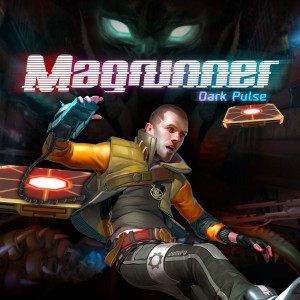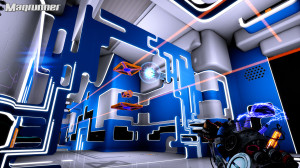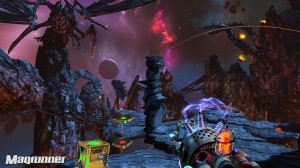
I managed to pick up Magrunner – Dark Pulse for free from Good Old Games. For free, it’s a great value, but even otherwise it has some good moments. It’s not Portal, but it had moments where it gave a similar feeling of satisfaction. Then there are other moments.
Generally this is a game where the problems are just missteps that could probably have been smoothed out with more playtesting, but they can ruin your experience as they are.
Fundamentals
The game is all based around magical magnetism. So long as you don’t get hung up on the physics, it’s a good puzzle mechanic. Generally, you can make things attract toward each other or repel each other. And that’s the mechanic of the game. That simplicity of concept I think is a great basis for a puzzle game. Like Portal (you can connect to points in space), this allows for the puzzles to play with the mechanics rather than just introducing more set pieces all the time.
It also has a story…for better or worse. Overall, it’s a feature to have something else going on, but the story does have a tendency to get in the way of playing the game. This is especially true when the game starts and makes you wait in a room while people talk at you (though they switch to talking to you while you can actually play the game later which is a large improvement).

The story is a Cthulhu-horror affair complete with cultists and so on. As a person who respects horror but doesn’t like playing horror games, I generally feel the horror becomes interesting looking static elements in the levels and rarely anything trying to really be scary. The developers also, very appropriately, keep the levels mostly with open pacing allowing you to solve them at your own rate. This makes the story (which also does improve eventually) a nice dash of flavor mostly without getting in the way (usually).
As far as puzzles and mechanics go, the levels are solvable with logic and not tricks. Some of the set pieces you need are a bit hard to notice at first glance, but overall, just looking around is all a player will need to be able to progress if they can identify what needs to happen next and works toward it. This gives a good sense of satisfaction as the levels mostly get harder in a reasonable way as time goes on. Generally mechanics are introduced simply and then expanded to be more interesting.
Refinement needed
The real problem with virtually every aspect of this game is a lack of polish. For many levels, this might be small things like the area making no affordances to help guide a player’s sight to logically progress through the space. Guiding sight is important in puzzles that involve a player moving around to see. Without helping, the player can feel frustrated because they just didn’t realize there was something above or below that was interesting to look at.

Physics comes up in virtually every puzzle in some way, but objects don’t interact in a way that’s perfect. There were several levels that I might move a cube I had magnetized with a platform and have to move the platform back and forth repeatedly to shake the cube into position. Now either I found a solution to the puzzle I shouldn’t have (which could be seen as a feature) or the physics wasn’t working well enough.
This is a large problem for a game like this. In a puzzle game, if a player has an idea and believes they have executed it, it should either succeed or fail. There is no satisfaction in having an idea and the world is just not cooperating in ways you feel you have very little control over. Why would I want to solve puzzles only to spend the next 10 minutes trying to convince a cube to move in the direction I wanted it to.
I feel the best example of this was in the third act of the game. In a puzzle, I needed to put a cube on a platform, move the platform far away from me, and then magnetize the cube the opposite of the platform so it would fly up to hit something. But it didn’t always work. This part was right before a strictly timed section but right after the checkpoint so I got to play this section many times. And even though I thought I had the platform in the right place and the cube sitting where I wanted it, sometimes it missed its mark and sometimes it hit. If it hadn’t succeeded the first time I tried, I might have thought I needed to do something else to solve the puzzle when it actually was either a problem that I couldn’t see where things were accurately enough or the physics system wasn’t reliable enough to solve the problem every time and there were no affordances to fix that.
Failing to solve a puzzle is acceptable and can lead to learning and a greater sense of accomplishment when the player does solve it. Failing to solve the puzzle due to a problem in the game is reason to stop playing.
Eventually in the game, you gain the ability to place a magnetic point on any flat surface. I have mixed feelings about this mechanic. It did allow for some interesting applications, but generally it was more often that it could provide frustrations as you could accidentally deploy it just as easily. This occurred if your aim was slightly off when trying to magnetize a part of the set. The result was a magnetic field slightly off of where you wanted it possibly conflicting with the object you were trying to alter. Add to this that there are many points where you are moving and trying to target something at the same time and plenty of mistakes will occur.
My biggest problem is I didn’t see the arbitrary point make any interesting puzzles. Sure, there were some obnoxious ones. On several occasions after getting this ability, the puzzle of magnetize something and drag it along a surface comes up. Sometimes it also has a time limit associated with it. But the puzzle isn’t interesting. Just removing those sections and making them standard platforms (or a special platform if it really needs to be different) would remove this annoying puzzle.

Affordances are extremely important in a puzzle game like this. Because a player has full freedom of movement and can target anything, their actual actions are virtually limitless. There are many places in the game where there are affordances to help both guide the puzzle and avoid positioning mistakes. For instance, platforms have defined paths and cubes try to stick to most places they should be put.
The arbitrary magnetic point goes against this because it can be put most places. In Portal, there was a lot of work done to make certain places able to support portals and other places that cannot to limit a players choice. Conceptually, non-flat surfaces could provide that here, but they aren’t used with any regularity (and some surfaces that look flat and are needed might have small areas that actually aren’t). If at least the spaces one could put this magnetic point were limited, that would make it a better mechanic, but I’m not sold that a cube couldn’t do the same thing.
The last major problem I see is that sometimes it feels like the designers thought that if doing something once was clever, making it more annoying and making it take five times longer is probably five times as clever. Even this walkthrough takes 6 minutes to get through this one puzzle in one level. It shows how much fiddling with something a puzzle can take even when the player actively knows how to solve the puzzle (and there is no satisfaction left after 6 minutes of just trying to get a game to cooperate).
Conclusion
So the big question is whether or not I would recommend the game. If one can get it cheap enough, then the answer would be sure. I could never say the game is great, but it showed a good start. I hope the developers make another that is just a bit more refined. There could be a great game polished out of this base.
In the end, I hesitantly recommend the game. There are some fun puzzles, but the game doesn’t seem to understand that things taking longer does not increase the fun.